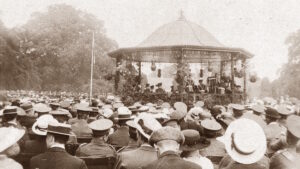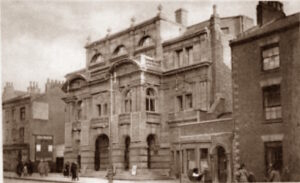A Town that Loved Its Parks
Thirteen parks lay within Northampton in 1924, each designed for a different purpose—children’s play, sports, quiet walks, or simple open space. Thanks to the smokeless boot and shoe industry, the grass really was green, not greyed by soot as in many industrial towns.
Far Cotton was the only district lacking a substantial park, relying instead on a 21-acre recreation ground described as ‘rather dreary‘.

Sundays with 10,000 Others
Northampton was a pioneer of Sunday band concerts. At one time opposed both by public houses and Nonconformist churches, these concerts became enormously popular—regularly attracting crowds of up to 10,000.
Sporting use of the parks grew too: cricket, bowls and tennis were all increasingly common.
Unemployment Relief That Created Beauty
A partnership between the Parks Committee and the Labour Exchange (‘Job Centre’) allowed 140 unemployed residents to work part or full-time maintaining and developing the parks, supplementing a permanent staff of 40.

A Library That Felt Alive
Northampton’s Central Library was widely considered one of the town’s greatest assets. The building was still relatively new, pleasant and well organised, avoiding the institutional feel of libraries in some larger industrial centres.
Lending was increasing year on year. A branch library opened at St James’ End in 1924 after growing public demand.
A Modest but Improving Museum
Northampton Museum was still in its early stages, but interest was rising rapidly. A diverse display of footwear and a strong fossil collection were highlights. Visitor numbers were also growing 50% year on year to 51,666 in 1922–23.

Cinemas, Theatres and Social Clubs
The town supported eight cinemas, though three others had closed recently. The films were surprisingly mostly American, with a few Continental offerings of lower quality. Two theatres presented musical comedy, revue, and occasional touring dramas.
Working men’s clubs were especially strong: thirteen clubs enjoyed by thousands of members.
Northampton Town Football Club regularly drew 7,000 spectators. Other leisure options included the large open market twice weekly and popular half-holiday char-a-banc trips into the countryside.
Read more in this series:
- Researching inequality – Northampton and the Welfare State
- Northampton on the Eve of Change: Life in 1913 and 1924
- Parks, Libraries and Leisure: Northampton’s Social Life in the 1920s
- Schools, Skills and Community: Education in Northampton, 1913–1924
- Work, Housing and Health: Northampton Behind the Numbers (1924)
© Copyright : Graham Ward. All rights reserved.